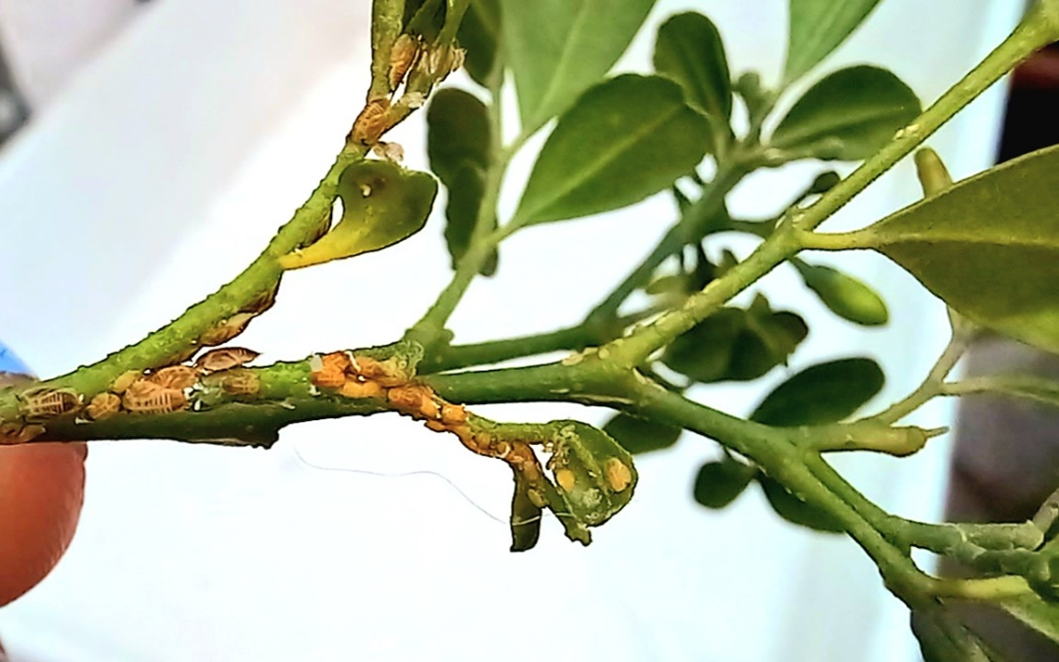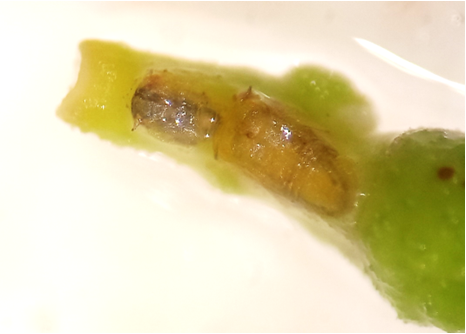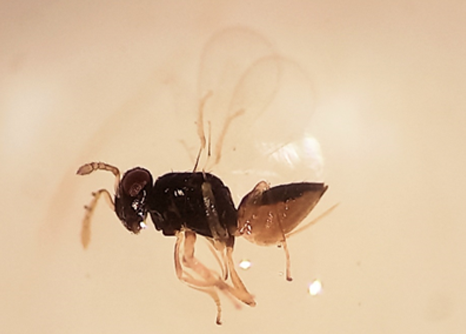Huanglongbing (HLB) Natural Enemy Variability in the Field
By Nadia Jimenez1 and Guillermo Logarzo2
1National Agency for Scientific Promotion (FONCYT)
2Foundation for the Study of Invasive Species (FuEDEI)
Argentina is one of the main world exporters of lemons and citrus in general, with a total of 140,000 productive hectares distributed in the northern part of the country. As in the U.S., these crops in Argentina are threatened by Citrus Greening Disease (HLB, Huanglongbing), a bacterial disease of citrus transmitted by the Asian citrus psyllid, Diaphorina citri (Figure 1), that transmits the bacterium from plant to plant. Affected trees have stunted growth, flower off-season, and produce small, discolored and poor quality fruit. But there is some hope in the shape of a small wasp (0.9 to 1 mm long), called Tamarixia radiata, which also comes from Asia, and lays its eggs on the young psyllid. When these eggs hatch, the emergent larvae feed in the psyllid, eventually killing it (Figures 2 and 3). The use of an introduced natural enemy to control an invasive pest, a technique known as classical biological control, could help to control HLB by reducing the transmission from infected to healthy trees. It has been observed in several countries that the efficiency of the wasp in eliminating the psyllid was associated with several genetic variations of a gene found in the mitochondria, and the Foundation for the Study of Invasive Species (FuEDEI) is collaborating with genetic studies of both the vector and parasitoid. We collected samples of both insects all over northern Argentina and discovered that the psyllid is very similar all over the region, while parasitoid genetic variation appears to be greater. Our preliminary results suggest more aggressive parasitoid populations could be singled out that would be better candidates for mass rearing and release in the field to control the pest. The parasitoid genetic variations could also be associated with adaptations to different climates and seasons, potentially providing an “assortment” of parasitoids adapted to different conditions.
 Figure 1. Asian citrus psyllids feeding on citrus branch.
Figure 1. Asian citrus psyllids feeding on citrus branch.

Figure 2. Two psyllids: left (darker), parasitized by T. radiata; right, healthy psyllid.

Figure 3. Female parasitoid under the microscope (real size, ca. 1 mm)
Contact: Nadia Jimenez
The Foundation for the Study of Invasive Species (FuEDEI), formerly known as the South American Biological Control Laboratory (SABCL), is located in Hurlingham, Argentina, near Buenos Aires. The SABCL/FuEDEI plays a crucial role collecting and providing candidate biological control agents for South American weeds and pest insects for federal and state cooperators, several U.S. universities, and research collaborators worldwide since 1962. FuEDEI’ s main mission includes exploring for natural enemies of target insects and weeds in Argentina and neighboring countries and conducting host-specificity testing to determine their safety for eventual release in the U.S. In addition, complementary research that investigates the ecology, behavior, taxonomy, and genetic differences based on geographic distribution is conducted on both targets and potential agents. Performing these studies in the region of origin of the target pest serves as an efficient prescreening process that reduces the number of biocontrol agent candidates shipped. This reduces the amount of quarantine work and valuable quarantine space occupation, the expenses related to permitting processes, the risks of escapes, and the release of maladapted or wrongly identified agents to a minimum, saving in costs and hazards. On some occasions these complementary studies help us understand why an exotic organism becomes invasive, which can, in turn, lead to determining novel strategies for their management.
